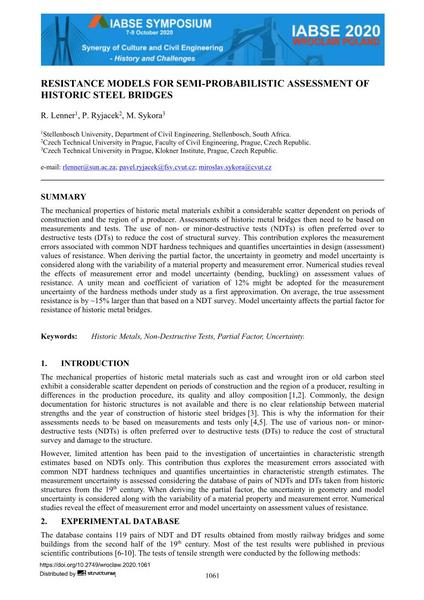Resistance Models for Semi-Probabilistic Assessment of Historic Steel Bridges

|
|
|||||||||||
Détails bibliographiques
| Auteur(s): |
R. Lenner
P. Ryjacek M. Sýkora |
||||
|---|---|---|---|---|---|
| Médium: | papier de conférence | ||||
| Langue(s): | anglais | ||||
| Conférence: | IABSE Symposium: Synergy of Culture and Civil Engineering – History and Challenges, Wrocław, Poland, 7-9 October 2020 | ||||
| Publié dans: | IABSE Symposium Wroclaw 2020 | ||||
|
|||||
| Page(s): | 1061-1068 | ||||
| Nombre total de pages (du PDF): | 8 | ||||
| Année: | 2020 | ||||
| DOI: | 10.2749/wroclaw.2020.1061 | ||||
| Abstrait: |
The mechanical properties of historic metal materials exhibit a considerable scatter dependent on periods of construction and the region of a producer. Assessments of historic metal bridges then need to be based on measurements and tests. The use of non- or minor-destructive tests (NDTs) is often preferred over to destructive tests (DTs) to reduce the cost of structural survey. This contribution explores the measurement errors associated with common NDT hardness techniques and quantifies uncertainties in design (assessment) values of resistance. When deriving the partial factor, the uncertainty in geometry and model uncertainty is considered along with the variability of a material property and measurement error. Numerical studies reveal the effects of measurement error and model uncertainty (bending, buckling) on assessment values of resistance. A unity mean and coefficient of variation of 12% might be adopted for the measurement uncertainty of the hardness methods under study as a first approximation. On average, the true assessment resistance is by ~15% larger than that based on a NDT survey. Model uncertainty affects the partial factor for resistance of historic metal bridges. |
||||
